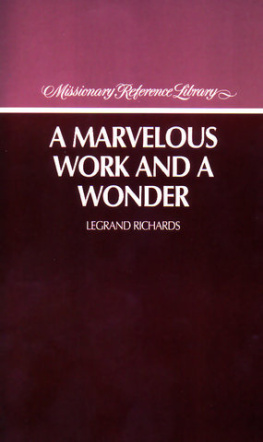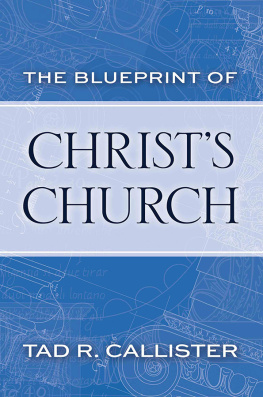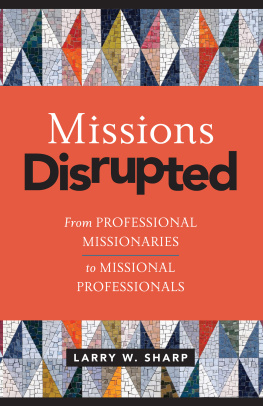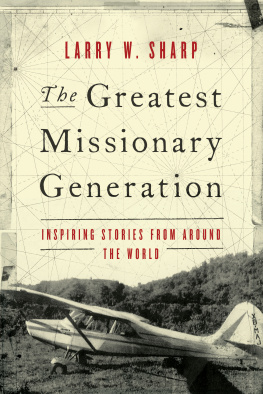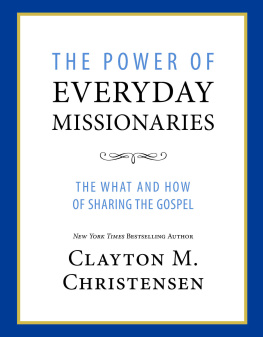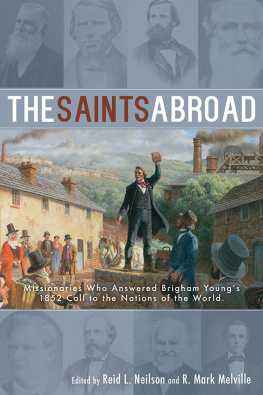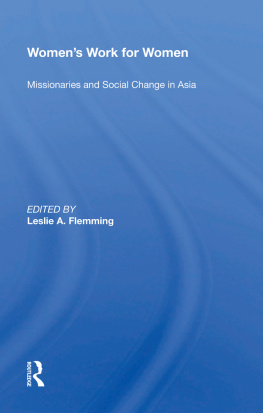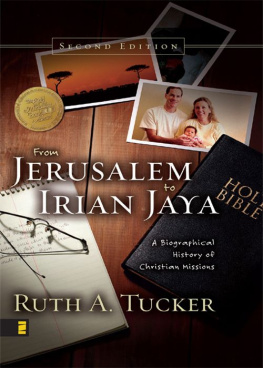Marvelous Work and a Wonder
LeGrand Richards
1950 Deseret Book Company. All rights reserved. No part of this book may be reproduced in any form or by any means without permission in writing from the publisher, Deseret Book Company, P.O. Box 30178, Salt Lake City, Utah 84130. This work is not an official publication of The Church of Jesus Christ of Latter-day Saints. The views expressed herein are the responsibility of the author and do not necessarily represent the position of the Church or of Deseret Book Company. Deseret Book is a registered trademark of Deseret Book Company.
Acknowledgments
The following acknowledgments are not intended to imply, directly or indirectly, any endorsement of this work, or to relieve the author of his full responsibility therefor.
The invaluable assistance rendered by my dear friend and associate, Lee A. Palmer, in editing the manuscript, and in following through with the details of publication, is acknowledged with the deepest feeling of gratitude.
Valuable suggestions and comments from members of the Publication Committee of the Church are gratefully acknowledged.
For the generous and competent assistance of Doyle L. Green, Marba C. Josephson, and Elizabeth J. Moffitt, Managing Editor, Associate Managing Editor, and Manuscript Editor, respectively, of The Improvement Era, the writer will ever be most grateful.
Appreciation is also expressed to my secretary, Mable S. Chapman, for copying and recopying the manuscript preparatory to the publication of this work.
LEGRAND RICHARDS
Salt Lake City, Utah
December 1, 1950
Preface
At the conclusion of Elder LeGrand Richards' presidency of the Southern States Mission of The Church of Jesus Christ of Latter-day Saints in 1937, he left with the missionaries an outline entitled "The Message of Mormonism." This outline was prepared to assist the missionaries in their study and presentation of the gospel in a systematic and logical manner. It has since been used in a number of missions and by stake missionaries. Repeated requests and suggestions that it be printed have influenced the decision to enlarge upon the original outline and have it published in book form. It is here presented under the title "A Marvelous Work and A Wonder."
Recently a letter was received from the president of a mission requesting permission to use this outline. The letter is quoted in part:
For some time I have been dreaming over a program of subjects for the missionaries to use in their contacts and follow-ups with investigators, subjects with a natural sequence that will make their message more effective and intelligible.
This morning I was cleaning out a drawer and ran across the answer to my dreamsdust covered and neglected. It was a mimeographed booklet entitled, "The Message of Mormonism," by LeGrand Richards. I have read it through, and it embodies just the thing I would like to place in the hands of each missionary.
Would it be agreeable to you if I make copies of it for this purpose? It is excellent and would be effective in stimulating systematic study and regulated presentations.
An added encouragement to publish this outline came through a request from a teacher at Brigham Young University for permission to mimeograph and use it in his work at that institution. He had been using the outline for the past eight years as a missionary, as a seminary teacher, and at Brigham Young University, where he was doing graduate work in religion, teaching three two-hour classes. An excerpt from his letter follows:
In all my Church work I have found this the most helpful of introductions to the restored gospel. I have often thought that this outline, by all means, ought to be circulated in all the missions of the Church in order that all missionaries might profit by its use, because it presents such a clear and comprehensive picture of the message we have for the world, and also it presents it in such a logical order... I consider it excellent. In fact, the best I have seen, and I am writing this with the hope that it will get more, yes, much more publicity and circulation. I have tested it now for eight years in active Church work and found it not wanting.
When this outline was first given to the missionaries of the Southern States Mission, a letter accompanied it with added suggestions for the presentation of the gospel message, which included the following:
By us the gospel is to be preached in all the world as a witness to all nations. (See Matt. 24:14; Rev. 14:6-7.)
We are the fishers and hunters the Lord promised to send forth in the last days to fish and hunt Israel "from every mountain, and from every hill, and out of the holes of the rocks." (See Jer. 16:16.)
We are sent out two and two as the seventy of old (see Luke 10:1) with this instruction from the Master:
And into whatsoever house ye enter, first say, Peace be to this house.
And if the son of peace be there, your peace shall rest upon it: if not, it shall turn to you again.
And in the same house remain, eating and drinking such things as they give: for the labourer is worthy of his hire. Go not from house to house. (Luke 10:5-7.)
In these words and those which follow in this chapter the Master indicated that those who receive his servants receive him. He seems to want to impress the seventy that when their peace rests upon a house the Lord has done his part of the work, and he then leaves the responsibility to his servants to remain there and deliver the whole message so it can stand as a witness for or against them; and hence the instruction: "Go not from house to house." Too often, because of lack of experience and preparation, our missionaries run away from their work instead of running to it. Ask yourself this question: "In how many homes have I explained our message in detail and completeness so it could stand as a witness against those who heard it?"
If we tell our story we have a right to be heard, regardless of the hundreds of Christian denominations already existent in the land.
If we properly tell our story, there is no need for argument, which should remove the fear from the heart of the missionary. Missionaries have usually felt that they were going forth to argue or debate and should be prepared; but if they are prepared to tell our story intelligently and enthusiastically, their hearers will become listeners and questioners.
By explaining a few principles of the gospel we have not delivered our message as a witness against the people, any more than a man has built a house by laying the foundation. How can a person judge as to the beauty of the house when the foundation only is laid, or even when part of the sidewalls are built? The same rule applies in the presentation of the gospelhow can a man judge as to its truth before he has heard it?
When we find a home where "the son of peace be there," we should have a definite aim to visit that home once a week for at least six months. If we will do this and present our message in a systematic and orderly manner, the people will either join the Church or admit that the message is true, but their social and family standing will not permit their accepting it, if they have followed with interest your presentation, realizing, of course, that the spirit of the Lord must accompany your efforts since "the letter killeth, but the spirit giveth life." (See 2 Cor. 3:6.)
In submitting this outline it is realized there are many things worthy of discussion which have not been mentioned. Some subjects may take more than one visit to present properly. However, these suggestions should be helpful in presenting the message in a systematic and impressive manner.

